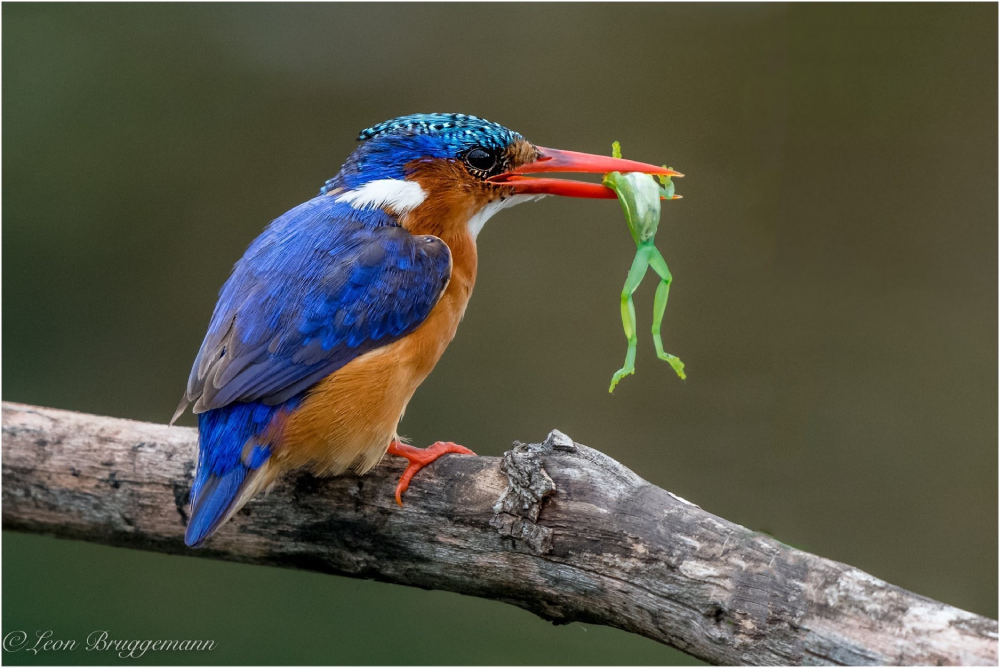Habitat and Distribution
Malachite Kingfishers are primarily found in sub-Saharan Africa, ranging from Senegal in the west to Ethiopia in the east, and extending down to South Africa. They thrive in a variety of freshwater habitats, including rivers, lakes, marshes, ponds, and even roadside ditches. The key requirement for their habitat is the presence of slow-moving or still water, which supports an abundance of their primary prey: small fish and aquatic insects.
These birds are highly adaptable and can be found at various altitudes, from sea level up to 2,200 meters (7,200 feet). They prefer areas with dense vegetation along the water’s edge, which provides essential cover and perching sites for hunting. The availability of clear water is crucial as it allows the kingfisher to spot and catch prey with precision.

Physical Description
The Malachite Kingfisher is a small bird, measuring approximately 13 centimeters (5.1 inches) in length and weighing around 17 grams (0.6 ounces). Despite its diminutive size, it boasts an array of striking colors that make it easily recognizable.
The crown and crest are an iridescent blue, reminiscent of the precious malachite stone from which the bird gets its name. The face and underparts are a vibrant orange, creating a bold contrast with the blue upperparts. The wings and back are a deep cobalt blue, adding to the bird’s jewel-like appearance. The bill is long, slender, and bright red, perfectly adapted for catching prey. Juveniles are slightly duller in coloration, with a black bill that gradually turns red as they mature.
Behavior and Feeding
Malachite Kingfishers are solitary and territorial birds, each maintaining a territory along a stretch of waterway. They are highly skilled hunters, primarily feeding on small fish, aquatic insects, crustaceans, and occasionally amphibians. The bird’s hunting technique is a marvel of nature. Perched on a branch or reed overlooking the water, the kingfisher remains motionless, scanning the water for signs of movement. Once prey is spotted, it dives with incredible speed and accuracy, often submerging completely before emerging with its catch.
After capturing its prey, the kingfisher returns to its perch to consume it. Small fish and insects are swallowed whole, while larger prey is often beaten against the perch to subdue it before being eaten. This behavior not only ensures the prey is dead but also removes any spines or sharp parts that could harm the bird.
Breeding and Nesting
The breeding season of the Malachite Kingfisher varies across its range, generally coinciding with the rainy season when food is abundant. During courtship, the male performs elaborate displays, including aerial chases and offering fish to the female as a form of courtship feeding.
Malachite Kingfishers are monogamous, with pairs working together to excavate a nest tunnel in a riverbank or sandy embankment. The tunnel, which can be up to a meter (3.3 feet) long, ends in a small chamber where the female lays a clutch of three to six eggs. Both parents take turns incubating the eggs, which hatch after about 14 days.
The chicks are altricial, hatching blind and helpless. They are fed a diet of regurgitated fish and insects by both parents and fledge after approximately three to four weeks. Even after leaving the nest, the young birds remain dependent on their parents for food for several more weeks.
Conservation Status and Threats
The Malachite Kingfisher is currently classified as Least Concern by the International Union for Conservation of Nature (IUCN). However, like many other species, it faces several threats that could impact its population in the future.
Habitat destruction and degradation pose significant risks. Wetland drainage, pollution, and deforestation reduce the availability of suitable habitats and prey. Additionally, water pollution from agricultural runoff and industrial waste can contaminate the bird’s food supply, leading to health issues and reduced reproductive success.
Climate change also presents a long-term threat by altering the distribution and availability of water resources. Changes in rainfall patterns can affect the timing and success of breeding, while extreme weather events can destroy nests and reduce prey availability.
Conclusion
The Malachite Kingfisher, with its vibrant plumage and remarkable hunting skills, is a true jewel of Africa’s waterways. Its presence is not only a delight to bird watchers but also an indicator of healthy freshwater ecosystems. Protecting this species requires concerted efforts to conserve and restore its habitats, ensuring that the vibrant flash of blue and orange continues to grace Africa’s rivers and lakes for generations to come.
In summary, the Malachite Kingfisher is more than just a beautiful bird; it is a symbol of the delicate balance of nature and the intricate interdependencies within aquatic ecosystems. Its conservation is vital, not only for the species itself but for the broader health of the environment it inhabits.









